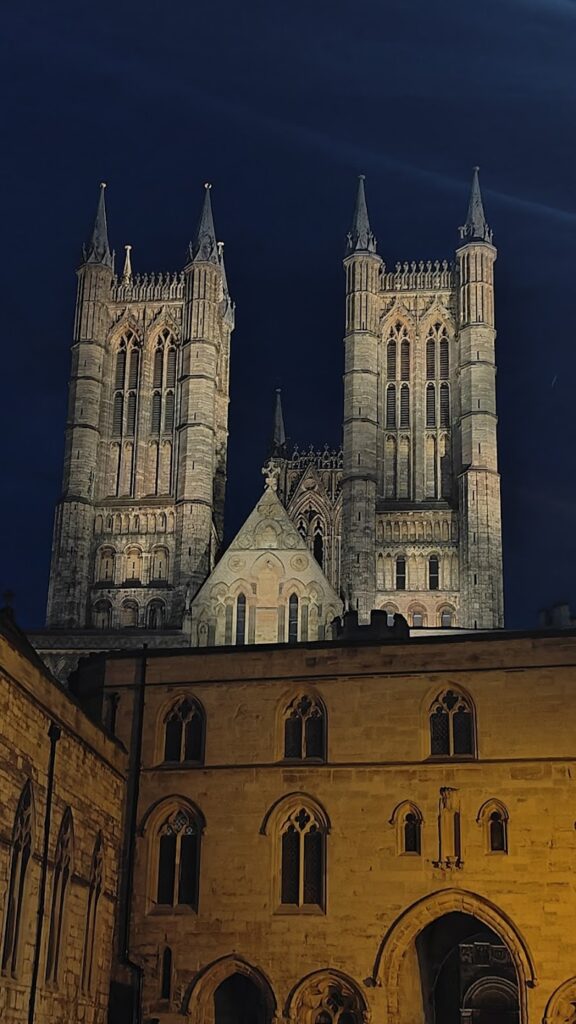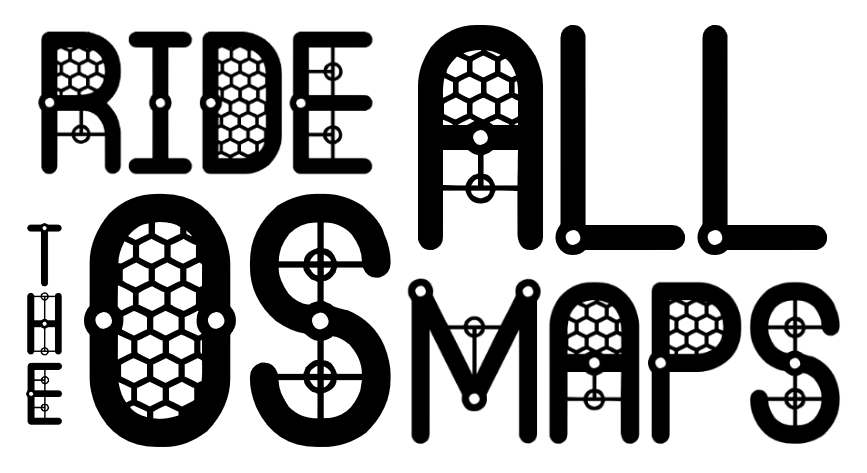
Having sent me on the longest unbroken straight line I can draw from my centrally located home, it was perhaps fitting that the magic spinner should next send me out along the very shortest of my cardinal spokes. Since I go where the spinner sends me, it was now my duty and pleasure to ride eastwards in a straight line – or as close as could be achieved – until I reached the east coast at Sutton on Sea in Lincolnshire. As luck would have it, the weather was very suitable for such a trip and so, after just one full day at home to catch up after returning from Scotland, I was on my way.

This trip could conceivably have been done in a single long day’s ride; but only if there was someone waiting at the end to bring me home by car. Sutton on Sea – and its slightly larger twin, Mablethorpe, which run into one another – cannot be reached by train. The nearest railheads along the coast are Cleethorpes to the north and Skegness to the south. The latter would involve a long and complicated journey home via Nottingham. The former is a tried and tested two hour journey home to Hathersage, with cheap, bike friendly trains departing every hour. It was a no brainer; but meant that this trip was going to spill into two days however I approached it. The question, therefore, was how to maximise the derivable benefit from those two days, ideally including some interest and involvement for Jenni in the process. And the answer that came to me in a moment of inspiration, was Lincoln.

A lot of my opportunistic thinking comes down to circumstances and a willingness to act spontaneously. Jenni had a hospital appointment for a CT scan in Nottingham on Saturday: further follow up to her spinal surgery in February (from which her overall recovery seems to be going quite well). On balance, it feels reassuring that she is still “on their books”. It has been a long road and we are not yet at the end of it; but things are certainly much improved. Anyway, that appointment would be a half day round trip from home by train and tram for a 10 minute appointment, which got me thinking.

Lincoln is a place we have fond memories of from the earliest, headiest days of our trans Atlantic relationship and, by coincidence, the Saturday in question would be our 35th wedding anniversary. One of the secrets to the success of our marriage might be considered not spending too much time together, and this has particularly applied over the years to our anniversary. I haven’t been counting; but it does seem uncanny how often we have been apart on 3rd August. Always for very good reasons, of course. If memory serves, I believe the first we actually spent together was our third anniversary. We missed last year’s because I was in North America, enjoying a short break in British Columbia with my daughter, Izzy. That was squeezed in between hiking for a month on the Pacific Crest Trail and cycling home across the continent from Boring, Oregon (see Boringtodull.com) Even by our standards, that was an exceptionally long absence, from mid June (when we parted in Pittsburgh) to mid September (when we were reunited in Reykjavik), but you get the general idea.
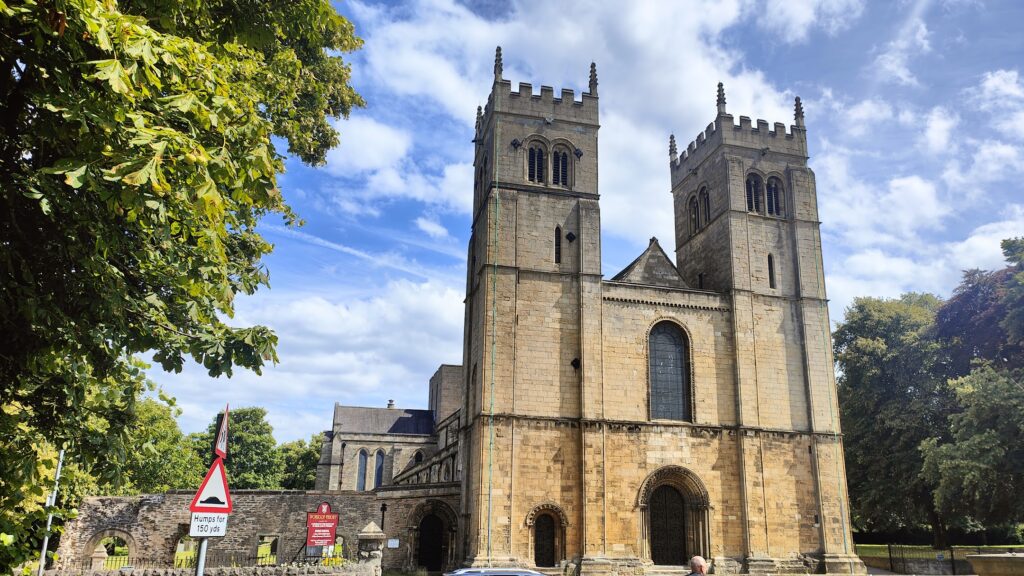
Anyway, I realised that after the hospital appointment, Jenni could just as easily reach me, in Lincoln, as she could get back home, and it would be a relatively quick and easy trip home by train the next morning. After a little time the day before to process this sudden proposal, she embraced the idea in a way that perhaps speaks volumes about how we have survived 35 years together and not feel any less committed to the whole enterprise as when it began. And that makes me happy. I think it makes her happy, too, most of the time.
My line to the coast passed slightly above Lincoln itself, through nowhere in particular, but it was an obvious overnight stop and it divided the ride into two neat parts. Day one was about 70 miles, with a hilly start and a gentle end. Day two would have been slightly shorter except for the extra 30 miles to Cleethorpes, which made it longer. Neither day required a horribly early start, or a very late end, and that suited me well.
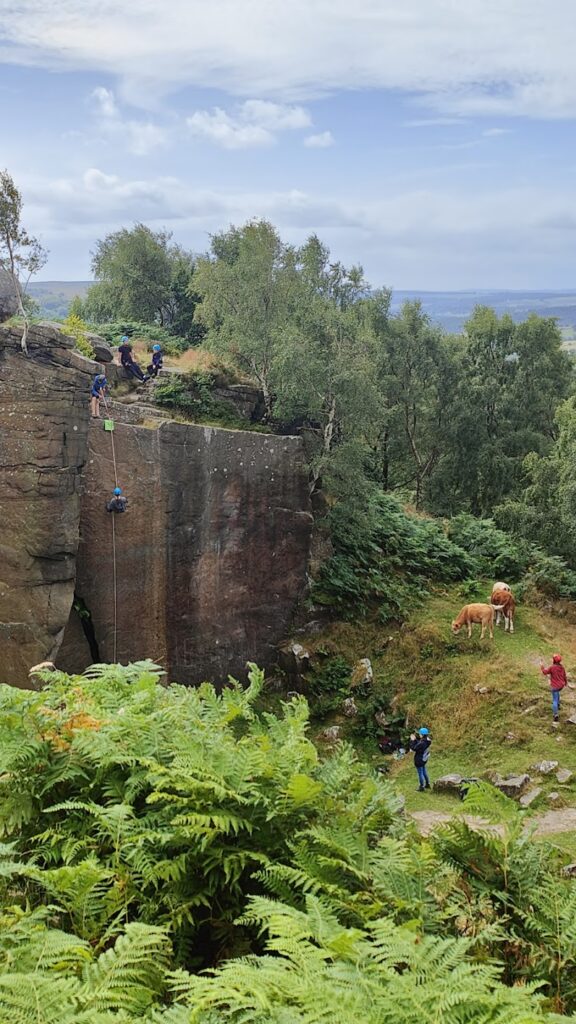
A line due east from Hathersage takes you up – and I very much mean up – the main road to the edge of Sheffield, then through its southern fringes before joining together small towns like Eckington, Killamarsh, Worksop and Retford. It’s a mixture of urban sprawl and fairly busy roads. I quite often cycle the 100 miles to Cleethorpes for a day out and a handy train ride home; but typically don’t follow this line because of the traffic. Today’s ride reminded me of the wisdom of that strategy. The terrain is actually pretty nice and the views are extensive; but it really isn’t the kind of cycling I enjoy. To be fair, everyone was respectful and I felt quite safe; but you can’t relax on roads like this. There were quieter sections and a few pretty villages like Harthill and Thorpe Salvin; but a few miles later you were back in a town, and the towns around here aren’t anything to write home about. I was in former coal mining country and the local economy of these places is still finding its way forward after the plug was pulled in the 1980s and 90s by Mrs Thatch.
I grew up not far from the likes of Retford and Worksop and my mum worked in these towns as a speech therapist. There are worse places, of course. But I have been privileged to live much of my adult life in a very beautiful place and I can’t help feeling a little underwhelmed when I go back. It was probably always a bit like this. It’s OK, just rather forgettable in the main. I have no real connection here any more and I can’t say I miss it. It would be nice to experience a whiff of nostalgia; but it’s long gone for me, I’m afraid. That’s the trouble with nostalgia: it isn’t what it used to be.
And thus I found myself in need of a late lunch in Worksop, and I got lucky by homing in on the main public park, which was busy today in the warm sunshine. There was a simple little cafe near the water splash play area, offering outside tables with views of Worksop’s principal architectural gem: its twin towered Norman priory church. So not so bad. I took what was on offer from their limited picture menu – a cheese and ham toastie – since they had run out of bacon rolls. I heard one of the friendly-but-unsophisticated staff say to the other “I like it when we run out of something, don’t you? Less things to serve.” She meant it, too.

Retford is a more loveable little town. It, too, has a pretty park, with a small river, the Idle, and the Chesterfield Canal running through it. Kids were enjoying the water in inflatable boats today and I didn’t blame them. But my favourite thing about Retford is its market place, presided over by a proper town hall, dating from 1866, with a cupola, faced on all four sides with clocks that chime every quarter hour. When I was young I used to liken it to Trumpton. There was a proper market taking place today as well. It felt good.
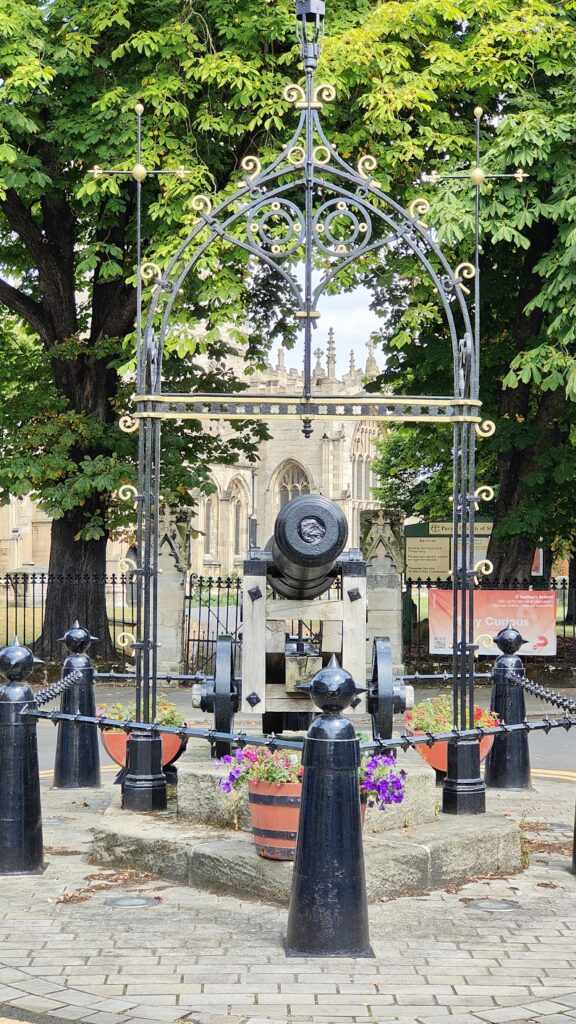
Retford has a fine, cruciform church in the middle, too, dedicated to St Swithun. Outside is a cannon captured by the British from the Russian army during the Crimean War in the Battle of Sebastopol in 1855. It was brought to the town by rail from London in 1858 and installed with suitable pomp and ceremony, after which chests of oranges and nuts were distributed to local children. When the cannon was restored in 2006, the events were re-enacted.
The cannon and adjacent church railings were removed for the national collection of metal during the Second World War and sent for smelting. A local councillor saved the cannon and it was reinstated after the war. A lucky escape.
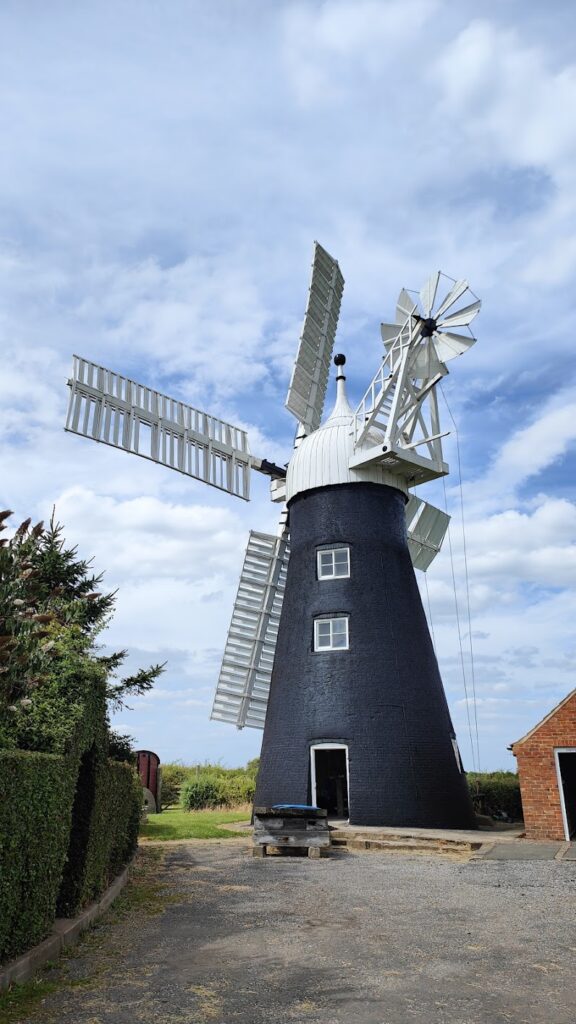
From here onwards, the cycling improved no end. Everything was now on small, quiet minor roads, all the way to Lincoln. Just east of Retford, over the last significant hill, I arrived at North Leverton windmill, in the shadow of the huge power stations of the Trent vale. I remember visiting this local landmark a few times as a child, and it was even on Blue Peter once, when John Noakes helped repair the sails. Built in 1813, it had remained a fully working windmill then in the 1970s and – thrillingly – it still is today! This being a summer Saturday, the white wooden sails were turning merrily in the brisk, warm breeze. It very much put me in mind of Windy Miller, grinding the corn in Camberwick Green (Trumptonshire).
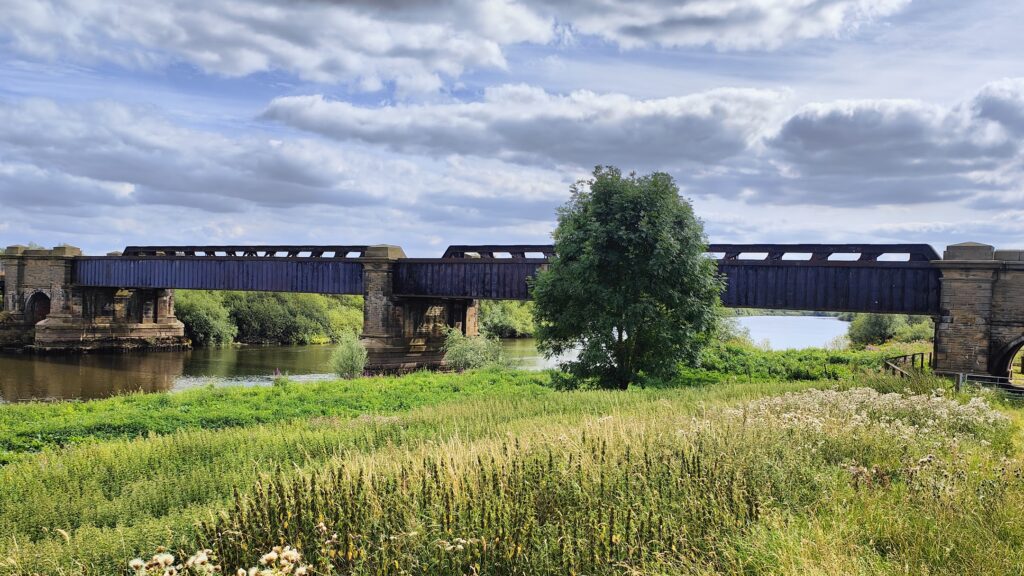
My next challenge was to cross the River Trent, one of the largest of Britain’s inland waterways. There are few bridging points along this tidal stretch of river and none of the road crossings fell close to my straight line. But there is an old railway bridge next to Cottam Power Station, previously off limits, and an item of curiosity ever since I read it had opened as a public footpath in 2015. This was the perfect opportunity to see if it also worked as a way through for bikes. And I am happy to report that, yes, it does. Kind of. They don’t make it easy. You have to ride from the end of a good bridleway across a grassy field to the flood embankment, and then get over a gate and up a staircase onto the bridge. It’s easier after that, and before you know it you have arrived in Torksey, Lincolnshire through the back door and no one knows!
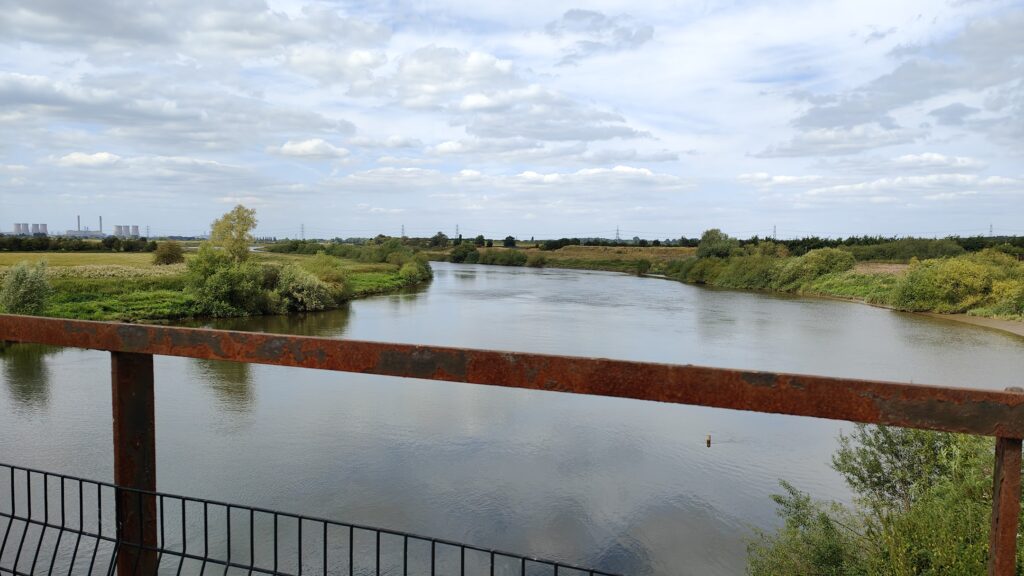
From this point the lanes got even tinier, if that were possible. My first lane ran right between the fairways of the local golf club and I was surprised by the sudden arrival of a stray golf ball flying through the air and bouncing off the road in front of me. In more ways than one, I certainly didn’t see that coming! Even the quietest roads can have hidden dangers.
I thought there would be nothing more to stop for before Lincoln; but I was wrong. Around a corner I came upon Bransby Horses Rescue and Welfare, which had a huge car park and a cafe (which had just closed) and, as the name suggests, provides a home for rescued horses. I read some of the information on their walls. It looked like a pretty big concern that carries out major rescue operations around the country, as well as helping rehabilitated animals find new homes and happier lives. I bought an ice cream. Every little helps.
The tiny lanes eventually led me to the village of Scampton, until recently synonymous with the RAF and specifically the Red Arrows aerobatic display team, who were based at the nearby airfield. There were various memorials to military aircraft in the village. Most visible was the largest clear perspex bus shelter I have ever seen, in the middle of the village green. On its curved roof was a depiction of the Red Arrows flying in formation over your head!
And then I climbed up and turned to reach Lincoln, a few miles away south along the edge of the limestone escarpment. From the top you could see absolutely miles back towards the west, from where I had just travelled. Cottam power station was easily visible, and behind it in the distance the more hilly country I had left behind. It was a great way to arrive.
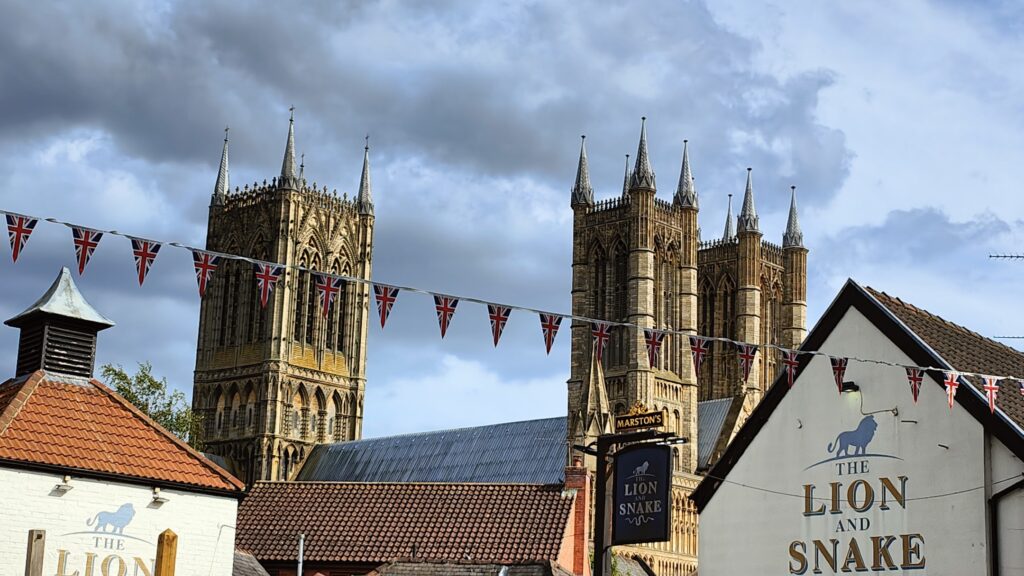
And what an arrival. A mile or so from the start of the suburbs, you catch sight of the castle walls, and then, rounding a corner, the full majesty of the triple towered mediaeval cathedral. It is simply magnificent and one of my favourite buildings in the world. It sits on its hilltop, looking down over the city below, and the world generally. Lincoln (or Lindum Colonia) was an import Roman city, and then a place of great strategic and religious importance to the Normans. The castle stands overlooking where the escarpment is breached by the River Witham, which is connected for navigation to the River Trent by the Roman Fossdyke. Even today you can see the cathedral from many miles away in most directions. On a clear day you can make it out from the hills above my house, almost fifty miles away as the crow flies.
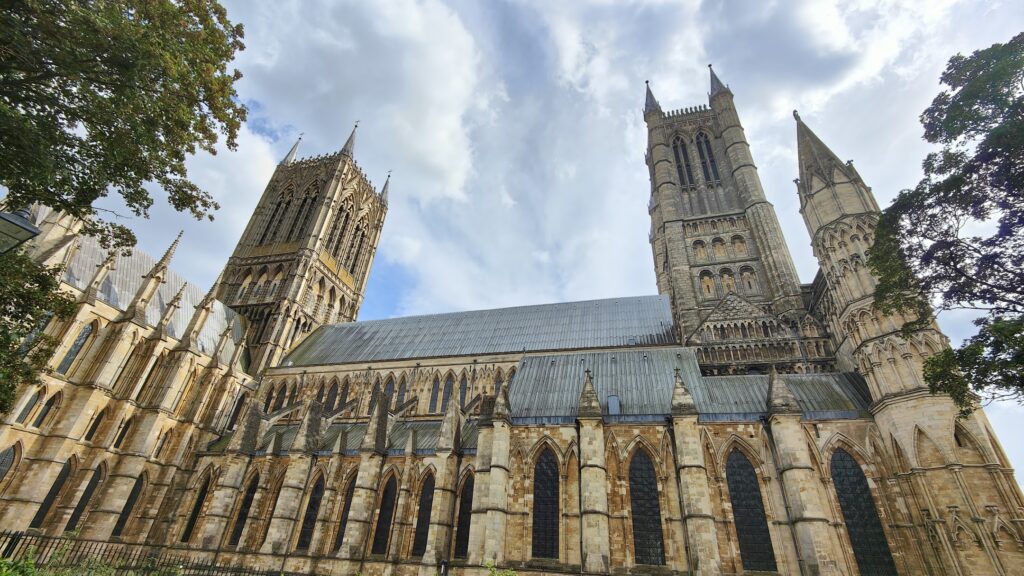
It isn’t just tall or large or impressive, it is also very beautiful. Quite feminine, despite being made of stone. And once upon a time the three towers had spires on top, making it the world’s tallest building between 1311 and 1549 when the 525 foot high central spire collapsed in a storm. No structure would reach a greater height until the Washington Monument was completed in 1884. I would love to travel back through time to see it at its full height. It must have been an incredible and inspiring sight.
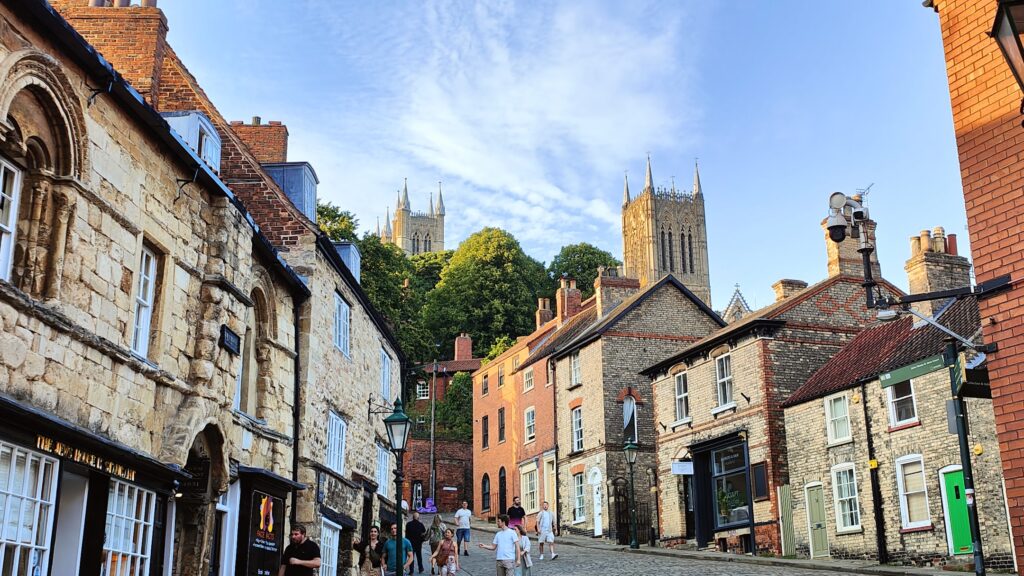
This afternoon the three towers were glowing in the late afternoon sunshine. All I had left to do was to ride down the steep hill into the newer part of Lincoln by the river, and find our accommodation and, minutes later, Jenni. In the evening we walked back up the cobbled Steep (which is very well named) and into the mediaeval city and had a wonderful anniversary dinner. The city below was vibrant with weekend revellers; but up here in the other, more refined Lincoln, things were a touch more serene, as befitting the ancient surroundings. As darkness fell, the cathedral floodlights came on and the glorious Gothic architecture shone out like the city was wearing a crown. Maybe if you saw this every day, you might stop noticing; but I remain mesmerised. It doesn’t get much better.
